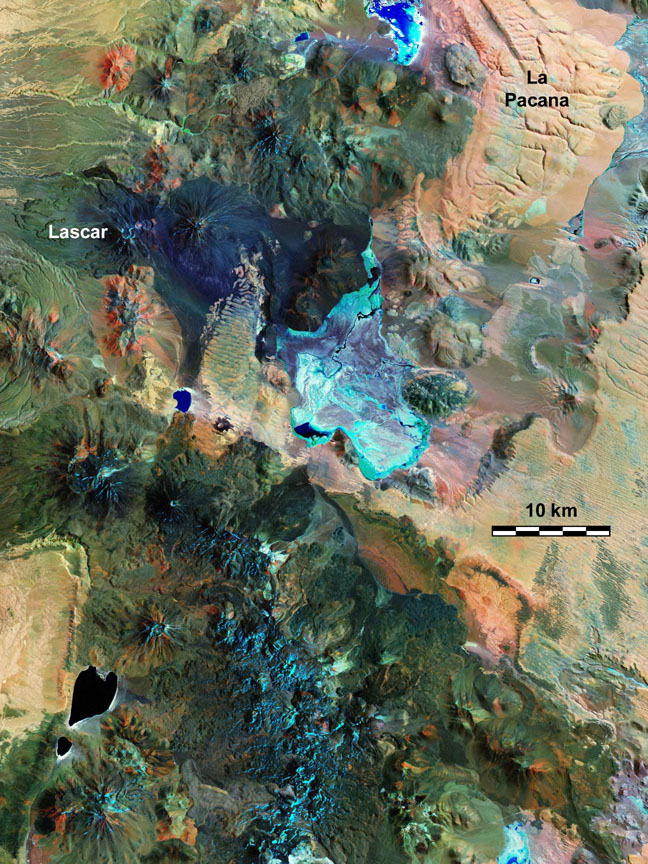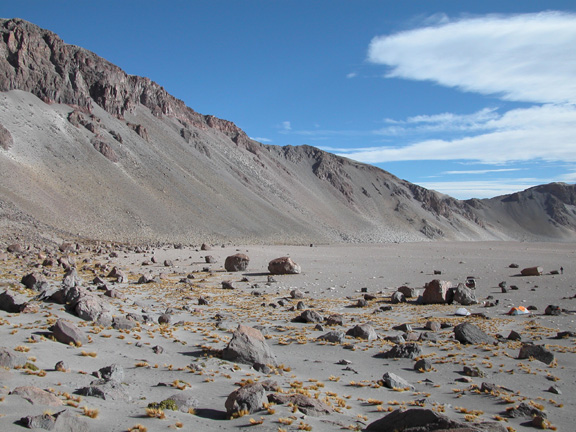|
I did my dissertation research in the Central Andes during the 1980's, when I studied the kinematics of faulting during the uplift of the Altiplano-Puna plateau (Marrett et al., 1994). In 2003 I began new research aimed at understanding structure within the modern volcanic arc. Of particular interest is the possibility of coupling between active deformation and magmatism. I also have begun a study of geyser eruption time series, with the goal of testing the hypothesis that their erratic eruption chronologies result from interaction among different geysers. Central Andes
This
Landsat 5 image shows the trace of the Nacimiento fault, east of
the Salar de Atacama in Chile. The fault runs from the
lower-left corner of the image, dams the two small lakes, and continues to
Lascar volcano (see below), which is the most active volcano in
the Central Andes. This structure is a prime candidate for
studying interaction of active deformation and magmatism within
the volcanic arc. A portion of the resurgent dome of La
Pacana caldera can be seen in the upper right.
A
pyroclastic
flow (erupted in 1993) on north side of Lascar volcano, Chile,
locally covers older (but not much older!) lava flows. The
active vent is left of the volcano's summit, where a small
vapor cloud can be seen in one of several craters.
The
caldera
wall of Cerro Blanco, Argentina, probably was produced by a major eruption 200
ka. Numerous fault scarps in the surrounding area provide
the opportunity to study active tectonic deformation.
Because the caldera is perched on the edge of the Puna plateau,
adjacent eroded areas will permit studying the structure of rocks
at depth.
View
along strike of a graben near the top of the Cordillera de San
Buenaventura, Argentina, thesis area for Masters candidate Austin Baldwin.
The fault scarp at the left edge of the photo continues across the
lava dome (dated at 430 ka) in the background. Other lava domes in
the area erupted atop fault scarps but have not yet been cut.
Fault
scarp (possible surface rupture of historic earthquake?) showing
dominantly right-slip motion, located between the Cordillera de
San Buenaventura and San Francisco volcano (top left) near the
Chile-Argentina border. The
scarp appears to represent the latest motion on a fault that cuts
the volcano and bounds the left side of its ridge-like shoulder (top center).
Fault
scarp in the Sierra de Bequeville, Argentina, showing dominantly right-slip
motion. Like many other right-slip faults in the Puna
plateau, mafic lava flows locally erupted along this fault (Marrett
and Emerman, 1992).
Geyser
cones at El Tatio geothermal field, Chile. The beehive shaped
geysers, behind the one erupting at the time of this photo, have
alternated activity during the past couple of years, with one
going dormant as the other renews activity.
|






